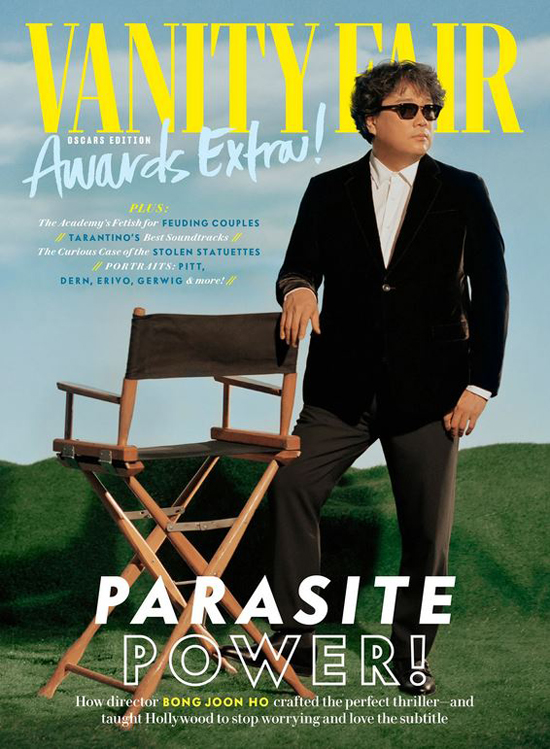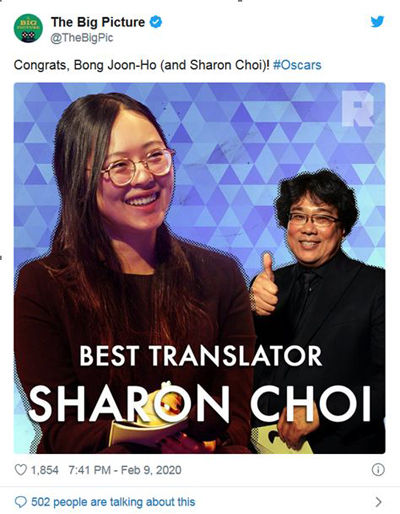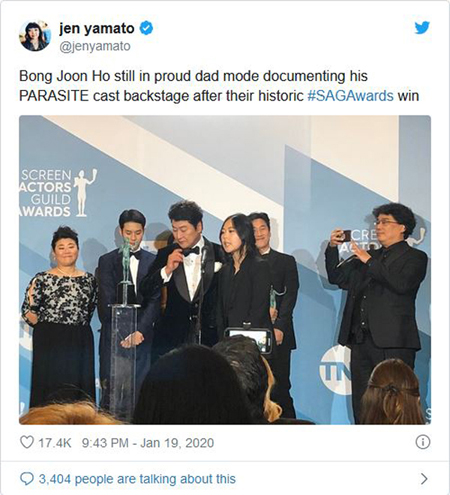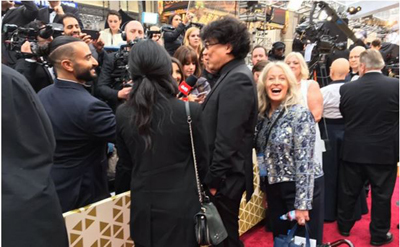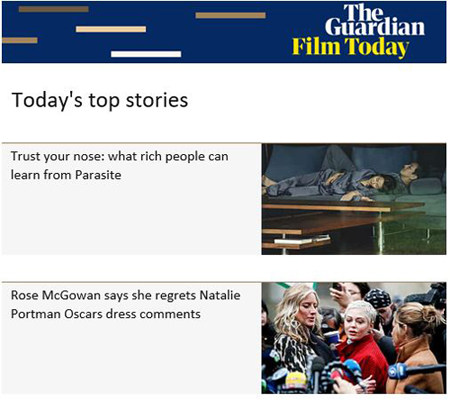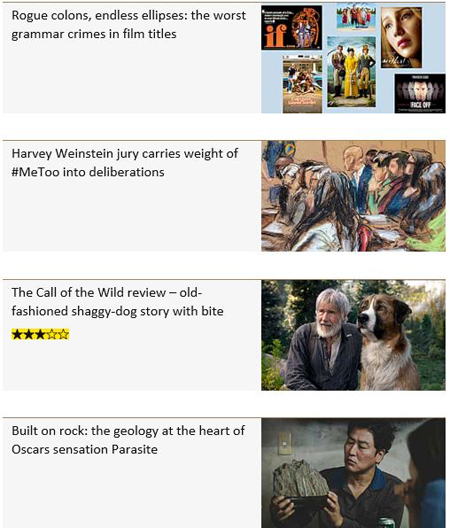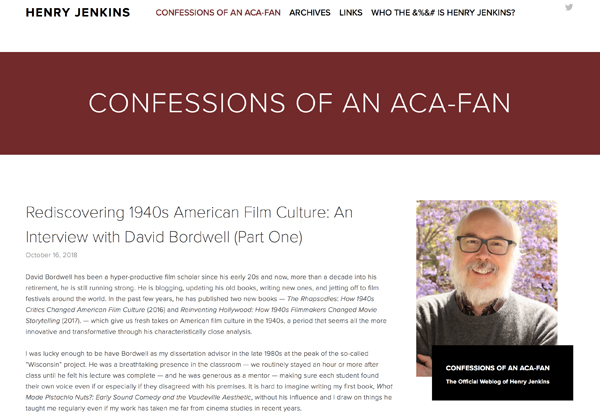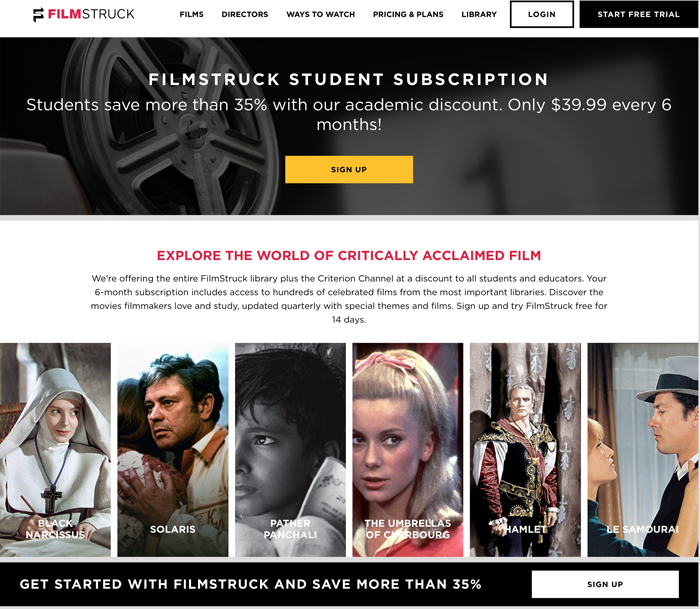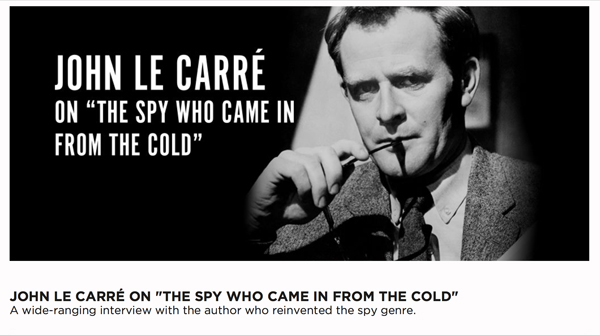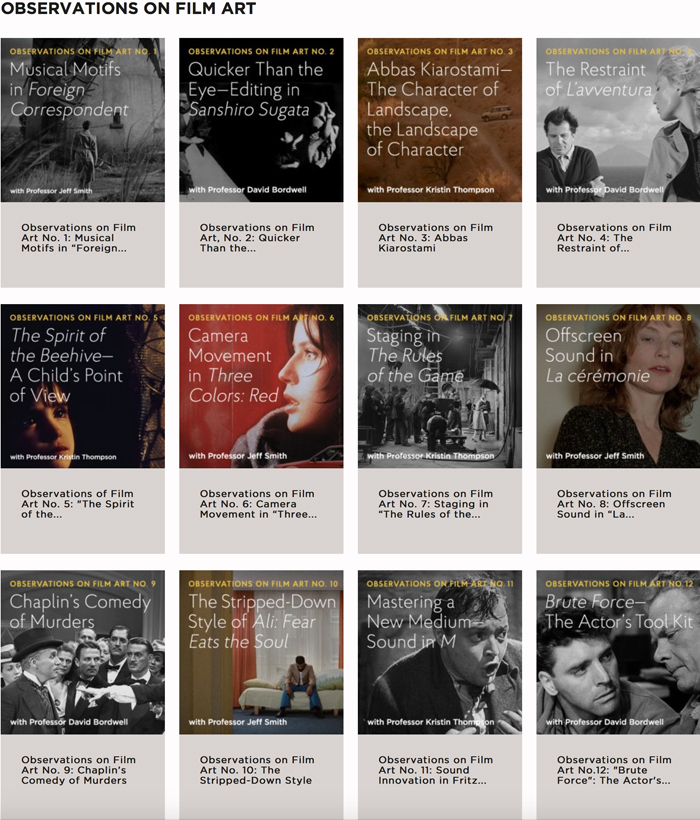Archive for the 'Internet life' Category
PARASITE fever
Kristin here:
It seems like anyone writing for an online or print periodical, whether media-oriented or not, is searching for some sort of hook on which to hang an article about Parasite and Bong Joon Ho. Some of these are a bit of a stretch, others are a bit ephemeral but interesting. All testify to the surprisingly broad interest in a relatively little-known director of the first foreign-language film ever to win the Best Picture Oscar.
Some of this burst of coverage undoubtedly stems from the fact that relatively few people know anything about Bong. Predictably there are many quick overviews of his career to catch people up, as well as plenty of interviews and of where-you-can-stream-Bong’s-films guides.
Here I offer a some links to a fair sampling of some of the less predictable pieces that I have run across. Some are quite bemusing. A few were published before the February 9 Academy Awards ceremony, but the flood has, not surprisingly, come after it.
Such pieces tend to fall into categories.
Items of Mise-en-scene
People are fascinated by the Parks’ gorgeous (at least on the surface) house and yard. Back on October 31, 2019, Architectural Digest, of all places, published an interview with Bong about the set. This is surely one of the most prestigious of non-media outlets to publish on the film. After the Oscars, The Guardian, which has diligently published on various aspects of the film (see bottom), caught up and ran a piece about the set being the “real star” of the film and considering it from a genre point of view.
The mysterious “viewing stone” has been discussed. The Guardian again (see bottom line of bottom image), on February 17, ran a story entitled “Built on rock: the geology at the heart of Oscars sensation ‘Parasite.'”
The Translator
Everybody seems to be enchanted by Sharon Choi, who has accompanied Bong internationally during the long awards season from Cannes to the Oscars. On February 10, Buzzfeed reported, “There’s a Ton of Love and Memes for the interpreter of ‘Parasite’ director Bong Joon Ho.” Sure enough, all over social media there are people gushing about her (above, from the Buzzfeed story).
On February 18, a Variety headline trumpeted, “Bong Joon Ho Interpreter Sharon Choi Relives Historic ‘Parasite’ Awards Season in Her Own Words (EXCLUSIVE).” Choi had, the story reveals, turned down “hundreds of interview requests” before allowing Variety to print her story. In fact, there are interviews with Choi available on the internet, but the Variety story is not an interview. It’s a memoir by Choi in which she recalls the awards season.
Meta
There are articles about the popularity of Parasite and Bong.
On January 20, into awards season but before the Oscars, Morgan Sung posted a piece on Mashable: “Parasite director Bong Joon Ho became a proud dad meme.” On social media, people were posting photos of Bong taking “proud dad” photos of his cast and crew getting awards (above). Note the number of likes and people “talking about this,” plus the presence of Sharon Choi in the group. The Mashable piece presents several more such snips.
Two days after the Oscar nominations were announced, on January 15 Junkee’s Joseph Earp posted about “Bong Joon-Ho, Viral Superstar,” proposing that Bong has become one of those rare directors who becomes a brand in himself. He picks up on Quentin Tarantino’s remark that Bong could become the new Spielberg.
On February 19, the livemint site reported gleefully that the day after the Oscars saw a 857% surge in searches on “Parasite.” This as opposed to 117% for 1917 and 132% for Jojo Rabbit. As the author remarks, “Bong Joon-ho’s tragicomedy thriller has been sweeping all awards and cleaning up at the box office, and people have not been able to stop talking (or searching) on Google.”
And why? “Search for director Bong Joon-ho increased for not only being the mastermind behind the film but also for his quirky sense of humour.”
I suppose the blog entry that you are now reading falls into this category as well. (And then there are our earlier comments.)
Lessons to be learned
On February 10, one of the odder stories I’ve seen went up on CNBC’s “Make It” page entitled: “‘Parasite’ director says his success is due to ‘a very simple lifestyle,’ not meeting a lot of people.” Why a business-oriented website would consider a South Korean film director’s lifestyle relevant to people aspiring to make a lot of money is anyone’s guess. Clearly CNBC was not able to get an interview with Bong so soon after the awards ceremony. Instead, the insights are derived from an article in the British Telegraph (behind a paywall). That piece is also dated February 10, and since it’s a review (albeit a late one), one must presume that its author had interviewed Bong earlier or derived his information from yet another source.
The Guardian (yet again) ran a story on February 18 headlined “Trust your nose: what rich people can learn from Parasite.” This turns out to be a satirical piece, including such tips as not buying a huge coffee table that intruders can hide under without being noticed.
This ‘n’ that
Even a periodical devoted to cuisine found a way to work in a story. On February 10, the day after the awards, Eater Los Angeles ran a story, “Oscar-Winning ‘Parasite’ Cast Parties Until 5 in the Morning at LA Koreatown Restaurant.” We learn, among other things, that “Bong Joon-ho hadn’t eaten anything all day and was so famished that the restaurant cooked up galbi jjim (braised short ribs), eundaegu jorim (braised spicy black cod), galbi (grilled short ribs), bibimbap, and seafood tofu pancakes for him and the cast.”
On February 15, Indiewire‘s Anne Thompson took us “Behind the Scenes of Bong Joon Ho’s Oscar-Winning PR campaign.” Behind the scenes is publicist Mara Buxbaum, seen above with Bong. To Bong’s left is presumably Sharon Choi, who, Thompson tells us, is writing a book about her experiences as Bong’s interpreter.
I suppose the Parasite fever really does result in part from the fact that this is the first time that a foreign-language film has won a best picture Oscar. It’s probably also to a considerable extent the fact that Bong is a charming person, modest, humorous, straightforward, and very talented, and he comes across as such in his acceptance speeches and interviews. People want to know more about him, as is suggested by looper’s February 12 piece on unknown facts about Bong. If they want to know what his favorite films are and maybe watch them, they can read No Film School’s “25 Favorite Films of ‘Parasite’ director Bong Joon Ho” (February 7).
The only people who dislike Parasite and presumably its maker seem to be President T***p and his gormless fans. On February 20, he decried the awarding of the best-picture Oscar to a foreign film:
And the winner is… a movie from South Korea! What the hell was that all that about? We’ve got enough problems with South Korea, with trade. On top of that, they give them the best movie of the year. Was it good? I don’t know. Let’s get Gone With the Wind back, please? Sunset Boulevard. So many great movies.
I shan’t try to unpack the levels of ignorance and misunderstanding jammed into that passage, which was cheered by many who had never heard of Parasite and had no idea what he was going on about. It does make me pause at the notion of T***p watching Sunset Blvd., if indeed he has, and that he seems to think re-released films are eligible for Oscars decades after they were made. I’ve got to believe he at least knows that Gone with the Wind and Sunset Blvd. have already been “gotten back” and are easily available for viewing in numerous formats. The point though, is that even he has a vague notion that Parasite (or, since he doesn’t know the title, “a movie from South Korea”) is good copy.
Two Parasite items on The Guardian’s February 18 film alert.
Two aca-fans being aca, and a little fannish
You probably know Henry Jenkins’ vast website “Confessions of an Aca-Fan.” It hosts blog entries, essays, interviews, and a podcast. As both a media scholar (the aca part) and a connoisseur (the fan), Henry has wide-ranging interests. He analyzes/enjoys/celebrates/criticizes film, TV, comics, music, and videogames (he testified about them to Congress). He’s also a big advocate for the role of media in education and political change.
Henry was a student of ours here at Madison, and I directed his dissertation. That became the book What Made Pistachio Nuts? Early Sound Comedy and the Vaudeville Aesthetic. Currently celebrating its twenty-fifth anniversary, it’s still very much worth reading as an original and entertaining cultural study of movie comedy. While doing his dissertation, Henry was also writing his trailblazing study of fan culture, Textual Poachers: Television Fans and Participatory Culture. (It now has an updated, twentieth-anniversary edition.)
Soon enough he followed that with another influential book, Convergence Culture: Where Old and New Media Collide. The idea of “transmedia storytelling” that Henry set forth here became a byword for the media industry as well as for scholars; his prophecy that we’d see a lot more of it has come true with a vengeance. We had a nifty dialogue about the idea online some years back (here and here).
And these are just three of his seventeen books! Henry is an epic multitasker, so he has found the energy to be an inspiring teacher as well. All of us at Wisconsin are thoroughly proud of him.
Naturally, when Henry asked me to participate in an email interview around my two 1940s books, The Rhapsodes and Reinventing Hollywood, I felt honored. Now he has run our conversation in four installments on his site, starting here.
I hope the answers I provide will shed light on my research projects. (As for the fan part: Yes, The Greatest Showman and Game Night are mentioned.) At the least I think people will learn a lot from Henry’s questions. Thanks to him for reigniting the spark of conversations we’ve had over the years.
10 million thanks
DB here:
On Tuesday 7 August, at some point midway through the morning (CST), somebody–in Key West, or Singapore, or Yale, I can’t be sure–logged onto this site and executed our ten millionth pageload.
No, prizes are not involved.
This site began counting pageloads, along with visits and other data, on 26 September 2006, when we started the blog. Those first entries were embarrassingly basic affairs. It would be months before we figured out how to include pictures, and years before we started to embed clips.
Since 2006 we have posted 876 entries (including this one) and run up many millions of words. We’ve hosted some roundtables and several guest posters: Tim Smith, Leslie Midkiff DeBauche, Rory Kelly, Nicola Mazzanti, Matthew Bernstein, Kelley Conway, Eric Dienstfrey, Amanda McQueen, Jim Udden, and our collaborator Jeff Smith. We’ve recorded encounters with Nina Paley, David Koepp, Joe Dante, Damien Chazelle, Phil Solomon, and other filmmakers. Mostly, though, this stuff has been churned out by Kristin and me.
We thought of the site as a supplement to Film Art, but it’s gone far beyond that. We’ve used it to provide access to published essays and books (Ozu and the Poetics of Cinema, Exporting Entertainment), to report on film festivals and conferences, to support other writers’ work, to jump into some current flaps both academic and journalistic, and to revisit research questions that obsess us. We’ve used it to set up video lectures, and to announce new books, by us and by others. Hell, some entries became books (Minding Movies, The Rhapsodes, Pandora’s Digital Box, Christopher Nolan: A Labyrinth of Linkages).
We’ve commented on trends in the film industry, such as 3D and global marketing. We’ve also tried to stir up enthusiasm for activities we think worthwhile, such as cognitive film studies, ambitious DVD publishing initiatives, and the FilmStruck streaming service.
It has been a ton of fun, and we don’t expect to stop any time soon. We busy ourselves with other things as well–writing for print publication, lecturing and visiting festivals, mounting our monthly Criterion Channel installments (which bear the same title as the blog). But the website has been a uniquely rewarding part of our lives. Through it we’ve made dozens of new friends and been exposed to fresh opinions and ideas.
I’m still surprised that we’ve drawn so many readers, since we decided at the start not to include Comments. We didn’t, and don’t, have time to monitor them. We’re stubbornly stuck in Web 1.5, treating this as essentially a personal, self-published magazine. But email responses, including corrections, are welcome.
We can’t yet imagine stopping. We’re delighted that in the age of Twitter, which oversimplifies every scrap of human affairs, and faced with the decline of blogs in general, thousands of people remain willing to click on, and maybe read, longish, para-academic efforts in film criticism and history.
So thanks to all our readers for encouraging us. And watch for our coverage of the upcoming Venice International Film Festival starting the end of the month!
We remain eternally grateful to our web tsarina Meg Hamel and our stalwart IT caballero Peter Sengstock.
The illustration up top comes, of course, from that exhilarating chronicle of human folly FailArmy.
P.S. 3 March 2019: This entry has been corrected. Originally it claimed ten million visits, not pageloads. Actually there were about seven million visits. I apologize for the error.
KT and DB, Venice International Film Festival, 2017.
The Celestial Arthouse: FilmStruck and Criterion Channel with an offer hard to refuse
DB here:
Here’s the big news. FilmStruck has instituted a student rate for subscriptions: 35% off the monthly rate, which means $39.99 for six months, or less than $7 a month. The Criterion Channel is included in this deal. Not only students but educators are eligible; it applies to anyone with an email address ending in .edu. You can get more information here.
In the current context, this seems to me a real bargain. Cord-cutting and cord-shaving are making streaming more and more common. But at least your cable subscription bundled a lot of channels offering movies from a wide range of sources. Now we face the prospect of each “content owner” setting up a dedicated streaming service.
Netflix and Amazon and Apple and YouTube are funding and buying exclusive rights to films and TV shows. Hulu remains as a source of Disney, Fox, and Warners properties, but that bundle is coming untied. Disney is planning to claw back most of its films for its proprietary streaming service. How soon before other studios mount their own streaming services?
The total cost of subscribing to your favorite services may rival a cable bill. Recognizing this, the studios have banded together to merge access to several of these sources in an app called Movies Anywhere. But that’s for convenience; you’re still paying out to many providers.
Ten years ago, Kristin and two major archivists expressed skepticism about the arrival of the Celestial Multiplex. Never would everything–really, everything–be available. In fact, as licenses expire and Peak TV drives streaming, Netflix and other services have trimmed their foreign and classic libraries.
This makes film FilmStruck an even more stupendous opportunity for film lovers. It remains a big, fat aggregator. Where else can you see, on a single night, a cache of 80s indies, eight movies by Phil Karlson, seven by Herzog, seven from Tunisia, Toshiro Mifune slicing and dicing his adversaries, a rare trove of French films made under Nazi Occupation, and several debut films by major filmmakers? And that’s before you get to the Criterion Channel, which currently offers Belle de Jour, Kore-eda’s Still Walking, The Spy Who Came in from the Cold (with a unique le Carré interview), The Color Wheel, and hundreds of other titles. Not the Celestial Multiplex, but close to a Celestial Arthouse. It’s what the prophets of cable TV told us to expect, but never arrived: access to world culture, at the time and place of your choosing.
I get it, dude. Movies.
Criterion’s new deal comes at the one-year anniversary of our series, “Observations on Film Art.” Kristin, Jeff Smith, and I have posted twelve installments, with more in the works. You can access them here, if you’re a FilmStruck subscriber. Several of these are developed further in blog entries; just go to our FilmStruck tag.
The anniversary set me thinking about streaming as a way of accessing movies. For home viewing I prefer discs, but more and more I watch streaming, usually to help my research. Several obscure 40s films I studied for my new book were available only on Amazon Prime, so those got my attention. Likewise, while revising our film history text, we checked on foreign-language titles not available on disc. But now I realize that to keep up with independent films I need to stream. The quite good I Don’t Feel at Home in This World Anymore didn’t get a theatrical release and doesn’t seem to be on DVD.
What startles and sort of dismays me most is the way Netflix and other services let recent releases swamp the classics and imports they still have. I’m also a bit put off by the vastness of the choice, the grid of thumbnails like stamps in a huge album. A friend told me of her husband browsing titles for so long that they give up deciding on a movie and opt for the latest episode of a TV show.
Video stores were also vast, but they came with benefits. Rereading Tom Roston’s enjoyable I Lost It at the Video Store: A Filmmakers’ Oral History of a Vanished Era, I was reminded how important gatekeepers and tastemakers are. The best rental shops had knowledgeable clerks, wild categories, and displays that highlighted choices by staff. What we now call “curation” was in place, sometimes in a gonzo way, to guide people through the mass of VHS boxes. Kevin Smith:
I’d try to tell people what to rent even if it was the same stupid shit over and over. I was like, “I get it, dude. Movies. Who gives a fuck what they are.” I loved talking with people. There was no Internet, so you couldn’t jump on a message board or Twitter. “This is what I loved about Guardians of the Galaxy. I am Groot! #fuckin’thismovierocks.” You didn’t get to do that. You gotta do that in person with people.
FilmStruck, while offering hundreds of titles, has regained some of that curatorial function. You can still wander freely through the catalogue, but there are also interviews, talking-head introductions, categories both obvious and imaginative, and video essays of the sort you’d find in DVD supplements. For our series, we try to hold onto a personal touch. The installments are monologues, but we think we’re steering you toward what to appreciate in the movies we talk about. At least there’s a little more sense of human contact that way. And we hope our enthusiasm shows that analyzing film aesthetics doesn’t have to be dry and bloodless.
Thanks as ever to our collaborators at Criterion: Kim Hendrickson, Grant Delin, Peter Becker, and their colleagues.












